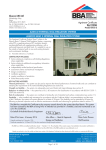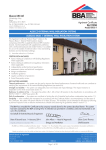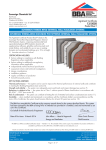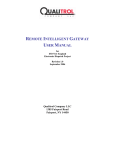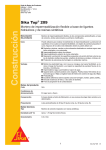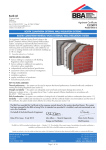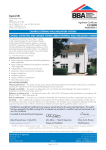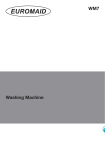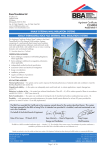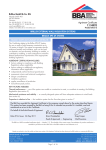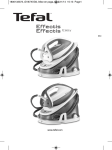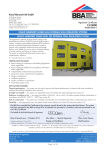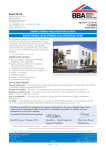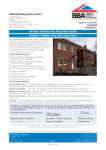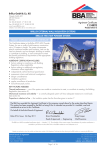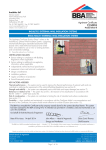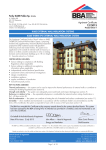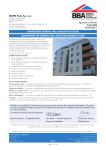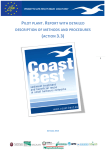Download Alsecco (UK) Ltd ALSECCO EXTERNAL WALL INSULATION
Transcript
APPROVAL INSPECTION TESTING CERTIFICATION Alsecco (UK) Ltd Whitebridge Way Stone Staffordshire ST15 8GH Tel: 01785 818998 Fax: 01785 818144 TECHNICAL APPROVALS FOR CONSTRUCTION Agrément Certificate 96/3247 e-mail: [email protected] website: www.alsecco.co.uk Product Sheet 1 ALSECCO EXTERNAL WALL INSULATION SYSTEMS ALSECCO ECOMIN 300 EXTERNAL WALL INSULATION SYSTEM This Agrément Certificate Product Sheet(1) relates to the Alsecco Ecomin 300 External Wall Insulation System. It is a mechanically fixed with supplementary adhesive system comprising mineral wool insulation slabs, glassfibre reinforcing mesh and render finishes. The system is for application to the outside of external walls of masonry or dense concrete construction in new or existing buildings. (1) Hereinafter referred to as ‘Certificate’. CERTIFICATION INCLUDES: • factors relating to compliance with Building Regulations where applicable • factors relating to additional non-regulatory information where applicable • independently verified technical specification • assessment criteria and technical investigations • design considerations • installation guidance • regular surveillance of production • formal three-yearly review. KEY FACTORS ASSESSED Thermal performance — the system can be used to improve the thermal performance of external walls and contribute to meet the Building Regulations (see section 6). Strength and stability — the system can adequately resist wind loads and has sufficient resistance to impacts and the wind loads normally experienced in the UK (see section 7). Behaviour in relation to fire — the system is classified A2-s1, d0 in accordance with the national Building Regulations (see section 8). Durability — when installed and maintained in accordance with the Certificate holder’s recommendations and the terms of this Certificate, the system is expected to have a life in excess of 30 years. The durability of the system can be extended to 60 years when using a mechanically fixed system, with stainless steel fixings [304 grade (1.4301)], plastic anchor materials such as polyamide (PA6 and PA6.6), polyethylene (PE) or polypropylene (PP) and an effective maintenance schedule (see section 13). The BBA has awarded this Certificate to the company named above for the system described herein. This system has been assessed by the BBA as being fit for its intended use provided it is installed, used and maintained as set out in this Certificate. On behalf of the British Board of Agrément Date of First issue: 18 December 2012 Sean Moriarty — Head of Approvals Greg Cooper Originally certificated on 6 December 1996 Energy and Ventilation Chief Executive Certificate amended on 12 February 2013 to include a reference to basecoat in Figure 1 and to augment the Durability statement in section 13.2. The BBA is a UKAS accredited certification body — Number 113. The schedule of the current scope of accreditation for product certification is available in pdf format via the UKAS link on the BBA website at www.bbacerts.co.uk Readers are advised to check the validity and latest issue number of this Agrément Certificate by either referring to the BBA website or contacting the BBA direct. British Board of Agrément Bucknalls Lane Watford Herts WD25 9BA ©2012 Page 1 of 17 tel: 01923 665300 fax: 01923 665301 e-mail: [email protected] website: www.bbacerts.co.uk Regulations In the opinion of the BBA, the Alsecco Ecomin 300 External Wall Insulation System, if installed, used and maintained in accordance with the provisions of this Certificate, will meet or contribute to meeting the relevant requirements of the following Building Regulations (the presence of a UK map indicates that the subject is related to the Building Regulations in the region or regions of the UK depicted): The Building Regulations 2010 (England and Wales) (as amended) Requirement: A1 Loading Comment: The system can sustain and transmit wind loads to the substrate wall. See sections 7.1 and 7.4 of this Certificate. Requirement: B4(1) External fire spread Comment: The system is classified A2-s1, d0 and, therefore, meets this Requirement. See sections 8.1 to 8.7 of this Certificate. Requirement: C2(b) Resistance to moisture Comment: The system provides a degree of protection against rain ingress. See sections 4.4, 10.1 and 10.2 of this Certificate. Requirement: C2(c) Resistance to moisture Comment: The system contributes to minimising the risk of interstitial and surface condensation. See sections 11.1 to 11.3 and 11.5 to 11.7 of this Certificate. Requirement: L1(a)(i) Conservation of fuel and power Comment: The system will enable, or contribute to enabling, a wall to meet the U value requirement. See sections 6.2 and 6.3 of this Certificate. Regulation: 7 Materials and workmanship Comment: Regulation: 26 CO2 emission rates for new buildings The system is acceptable. See sections 13.1 and 13.2 and the Installation part of this Certificate. The system will enable, or contribute to enabling, a wall to meet the U value requirement. See sections 6.2 and 6.3 of this Certificate. Comment: The Building (Scotland) Regulations 2004 (as amended) Regulation: 8(1)(2) Regulation: Standard: 9 1.1 2.3 2.6 2.7 3.10 3.15 6.1(b) 6.2 7.1(a)(b) Comment: Statement of sustainability The system can contribute to meeting the relevant requirements of Regulation 9, Standards 1 to 6, and, therefore, will contribute to a construction meeting the bronze level of sustainability as defined in this Standard. Comment: Regulation: Carbon dioxide emissions Buildings insulation envelope Walls insulated with the system will satisfy these Standards, with reference to clauses 6.1.1(1)(2), 6.1.2(1)(2), 6.2.1(1)(2), 6.2.2(1)(2), 6.2.3(1)(2) and 6.2.4(1)(2) of this Standard. See sections 6.2 and 6.3 of this Certificate. Comment: Standard: Condensation Walls insulated with the system will satisfy the requirements of this Standard, with reference to clauses 3.15.1(1)(2), 3.15.4(1)(2) and 3.15.5(1)(2). See sections 11.4 to 11.7 of this Certificate. Comment: Standard: Standard: Precipitation Walls insulated with the system will contribute to a construction satisfying this Standard, with reference to clauses 3.10.1(1)(2) and 3.10.2(1)(2). See sections 4.4, 10.1 and 10.2 of this Certificate. Comment: Standard: Spread on external walls The system is unrestricted by this Standard, with reference to clause 2.7.1(1)(2). See sections 8.1 to 8.4 and 8.8 of this Certificate. Comment: Standard: Spread to neighbouring buildings The system has a surface spread-of-flame classification of A2-s1, d0 and mineral wool itself is noncombustible and, therefore, can meet this Standard, with reference to clauses 2.6.1(1)(2), 2.6.2(1)(2), 2.6.4(1)(2), 2.6.5(1) and 2.6.6(2). See sections 8.1 to 8.4 and 8.8 of this Certificate. Comment: Standard: Structural protection The use of the system may be restricted by this Standard in some applications, with reference to clause 2.3.1(1)(2). See sections 8.1 to 8.4 and 8.8 of this Certificate. Comment: Standard: Building standards applicable to construction Structure The system can sustain and transmit wind loads to the substrate wall, with reference to clause 1.1.1(1)(2). See sections 7.1 and 7.4 of this Certificate. Comment: Standard: Fitness and durability of materials and workmanship The use of the system satisfies the requirements of this Regulation. See sections 12.1, 13.1 and 13.2 and the Installation part of this Certificate. Comment: 12 Building standards applicable to conversions All comments given for this system under Regulation 9, Standards 1 to 6, also apply to this Regulation, with reference to clause 0.12(1)(2) and Schedule 6(1)(2). (1) Technical Handbook (Domestic). (2) Technical Handbook (Non-Domestic). Page 2 of 17 The Building Regulations (Northern Ireland) 2012 Regulation: 23 Fitness of materials and workmanship Comment: Regulation: 28 Resistance to moisture and weather The system is acceptable. See sections 12.1, 13.1 and 13.2 and the Installation part of this Certificate. Walls insulated with the system will satisfy this Regulation. See sections 4.4, 10.1 and 10.2 of this Certificate. Comment: Regulation: 29 Regulation: 30 36 39 Conservation measures The system will enable, or contribute to enabling, a wall to meet this Regulation. See sections 6.2 and 6.3 of this Certificate. Comment: Regulation: External fire spread The system has a Class A2-s1, d0 surface and can satisfy this Regulation. See sections 8.1 to 8.7 of this Certificate. Comment: Regulation: Stability The system can sustain and transmit wind loads to the substrate wall. See sections 7.1 and 7.4 of this Certificate. Comment: Regulation: Condensation Walls insulated with the system will satisfy the requirements of this Regulation. See sections 11.5 to 11.7 of this Certificate. Comment: 40 Comment: Target carbon dioxide emission rate The system will contribute to a building satisfying its target emission rate. See sections 6.2 and 6.3 of this Certificate. Construction (Design and Management) Regulations 2007 Construction (Design and Management) Regulations (Northern Ireland) 2007 Information in this Certificate may assist the client, CDM co-ordinator, designer and contractors to address their obligations under these Regulations. See section: 3 Delivery and site handling (3.2) of this Certificate. Additional Information NHBC Standards 2013 NHBC accepts the use of the Alsecco Ecomin 300 External Wall Insulation System, provided it is installed, used and maintained in accordance with this Certificate, in relation to NHBC Standards, Part 6 Superstructure (excluding roofs), Chapter 6.9 Curtain walling and cladding Technical Specification 1 Description 1.1 The Alsecco Ecomin 300 External Wall Insulation System (see Figure 1) comprises: • adhesive — Thermastick MK and MP — cement-based adhesives, each comprising limestone sand conforming to BS EN 13139 : 2002, cement conforming to BS EN 197-1 : 2011, and additives, and supplied as a powder to which clean water is added — Armatop A and MP — cement-based adhesives, each comprising limestone sand conforming to BS EN 13139 : 2002, cement conforming to BS EN 197-1 : 2011, and additives, and supplied as a powder to which clean water is added • insulation — mineral wool insulation — available as dual density and high density slabs and lamella in sizes up to 1200 mm by 600 mm and in thicknesses from 20 mm to 200 mm. Nominal densities are up to 140 kg·m–3, 140 kg·m–3 and 85 kg·m–3 and tensile strengths of 5kPa, 14 kPa and 80 kPa respectively, in accordance with BS EN 13162 : 2008 • mechanical fixings — anchors of adequate length to suit the substrate and insulation thickness: — polyethylene- or polyamide-ribbed with a stainless steel, galvanized steel or polyamide central pin, approved by the BBA and the Certificate holder, and used as supplementary fixings — stainless steel washer and pin [304 grade (1.4301)] • basecoat — Armatop A and MP — cement-based basecoats, each comprising limestone sand conforming to BS EN 13139 : 2002, cement conforming to BS EN 197-1 : 2011, and additives, and supplied as a powder to which clean water is added Page 3 of 17 • reinforcement — Alsecco Glass-fibre Mesh Universal-Aero — a 1.1 m-wide mesh (6 mm by 6 mm) of multi-stranded alkali-resistant glassfibres, having a polymer coating and a nominal weight of 160 g·m–2 — Alsecco Glass-fibre Mesh 32 — a 1.1 m-wide mesh (4 mm by 4 mm) of multi-stranded alkali-resistant glassfibres, having a polymer coating and a nominal weight of 160 g·m–2 • primer — Top Primer P — an acrylic, resin-based emulsion containing fine fillers, pigment and coalescing agent used as a bonding medium and pre-coat to control suction — Top Primer Si — a silicate/acrylic resin-based emulsion containing fine fillers, pigment and coalescing agent used as a bonding medium and pre-coat to control suction — Top Primer SC — an acrylic, resin-based emulsion containing fine fillers, pigment and coalescing agent used as a bonding medium and pre-coat to control suction • render finish — Alsilite F-Aero — a cement-based, ready-mixed basecoat or topcoat comprising limestone sand conforming to BS EN 13139 : 2002, cement conforming to BS EN 197-1 : 2011, and additives, and supplied as a powder to which clean water is added, with a particle size of 1.5 mm — Alsilite R-Aero — a cement-based, ready-mixed basecoat or topcoat comprising limestone sand conforming to BS EN 13139 : 2002, cement conforming to BS EN 197-1 : 2011, and additives, and supplied as a powder to which clean water is added, with a particle size of from 2 mm to 4 mm — Alsilite T-Aero — a cement-based, ready-mixed basecoat or topcoat comprising limestone sand conforming to BS EN 13139 : 2002, cement conforming to BS EN 197-1 : 2011, and additives, and supplied as a powder to which clean water is added, with a particle size of from 2 mm to 5 mm — Alsitect R — a pre-coloured, ready-mixed, silicate-based, textured coating — Alsitect T — a pre-coloured, ready-mixed, silicate-based, textured coating — Duratop A — a cement-based, ready-mixed basecoat or topcoat comprising limestone sand conforming to BS EN 13139 : 2002, cement conforming to BS EN 197-1 : 2011, and additives, and supplied as a powder to which clean water is added — Miratect R — pre-coloured render, comprising limestone sand conforming to BS EN 13139 : 2002, cement conforming to BS EN 197-1 : 2011, and polymers, and supplied as a powder to which clean water is added — Miratect S — pre-coloured render, comprising limestone sand conforming to BS EN 13139 : 2002, cement conforming to BS EN 197-1 : 2000, and polymers; supplied as a powder to which clean water is added — Miratect T — pre-coloured render, comprising limestone sand conforming to BS EN 13139 : 2002, cement conforming to BS EN 197-1 : 2011, and polymers, and supplied as a powder to which clean water is added — Orgatect F — a pre-coloured, ready-mixed, acrylic-based textured coating — Orgatect R — a pre-coloured, ready-mixed, acrylic-based, textured coating — Orgatect T — a pre-coloured, ready-mixed, acrylic-based textured coating — Silitect R — a pre-coloured, ready-mixed, silicate-based, textured coating — Silitect T — a pre-coloured, ready-mixed, silicate-based, textured coating. Figure 1 Alsecco Ecomin 300 External Wall Insulation System Page 4 of 17 1.2 Ancillary materials also used with the system are: • Alsecco profiles — available in aluminium, stainless steel and PVC-U, comprising: — base profile — edge profile — corner profile — render stop profile — movement joint — expansion joint • Alsecco profile connectors and fixings — as approved by the BBA and the Certificate holder • Alsecco sealing tape — pre-compressed expanding polyurethane foam tape • Alsecco acrylic-based joint sealant. 1.3 The system comprises components selected from Table 1. Insulation slabs are mechanically fixed to the external surface of the wall with Thermastick MK or MP or Armatop A or MP used as a supplementary adhesive (see Figure 2). The insulation slabs are protected by a basecoat containing a glassfibre reinforcement mesh. After allowing the basecoat to dry, a top coat is applied to the required thickness. Table 1 Alsecco Ecomin 300 system summary Component Product Adhesive Thermastick MK or MP Armatop A or MP Insulation mineral wool slabs or lamella Fixing A range of anchors, each covered by an ETA in accordance with ETAG 014 Basecoat Armatop A or MP Reinforcement Alsecco Glass-fibre Mesh Universal-Aero or Alsecco Glass-fibre Mesh 32 Primer Top Primer P, Si or SC Finish coat Alsilite F-Aero, R-Aero or T-Aero Alsitect R or T Duratop A Miratect R, S or T Orgatect F, R or T Silitect R or T Figure 2 Typical section at base adhesive mortar mechanical fixing insulation slab reinforcement mesh basecoat topcoat base and extension profiles dpc substrate 2 Manufacture 2.1 Components are manufactured by the Certificate holder or bought-in from suppliers to an agreed specification. 2.2 All components are subject to routine in-factory quality control. 2.3 As part of the assessment and ongoing surveillance of product quality, the BBA has: • agreed with the manufacturer the quality control procedures and product testing to be undertaken • assessed and agreed the quality control operated over batches of incoming materials • monitored the production process and verified that it is in accordance with the documented process Page 5 of 17 • evaluated the process for management of nonconformities • checked that equipment has been properly tested and calibrated • undertaken to carry out the above measures on a regular basis through a surveillance process, to verify that the specifications and quality control operated by the manufacturer are being maintained. 2.4 The management system of Alsecco (UK) Ltd has been assessed and registered as meeting the requirements of BS EN ISO 9001 : 2008 by SQS (Swiss Association for Quality and Management Systems) (Certificate No 37528). 3 Delivery and site handling 3.1 The insulation is delivered to site wrapped in polythene. Each pack carries the product identification and batch numbers. 3.2 Components are delivered to site in the packagings and quantities as listed in Table 2. Each package carries the product identification, manufacturer’s batch number and the BBA logo incorporating the number of this Certificate. Table 2 Component supply details Component Quantity and packaging adhesives 25 kg paper bag Alsecco Glass-fibre Mesh Universal-Aero and 32 1.1 m wide rolls, 50 m length Armatop A and MP and Duratop A 25 kg paper bag primer 25 kg polythene bag render finish 25 kg polythene tub or bag mechanical fixings boxed by manufacturer 3.3 The insulation should be stored on a firm, clean, level base, off the ground and under cover until required for use. Care must be taken when handling the insulation to avoid damage. 3.4 The powder adhesives, basecoat and topcoats must be stored in dry conditions, off the ground, and be protected from moisture. Contaminated materials should be discarded. Assessment and Technical Investigations The following is a summary of the assessment and technical investigations carried out on the Alsecco Ecomin 300 External Wall Insulation System. Design Considerations 4 General 4.1 The Alsecco Ecomin 300 External Wall Insulation System, when installed in accordance with this Certificate, is effective in reducing the thermal transmittance (U value) of walls of new and existing buildings. It is essential that the detailing techniques specified in this Certificate are carried out to a high standard if the ingress of water into the insulation is to be avoided and the full thermal benefit obtained from treatment with the system. Only details specified by the Certificate holder should be used. 4.2 The system will improve the weather resistance of a wall and provide a decorative finish. However, it may only be installed where there are no signs of dampness on the inner surface of the wall other than those caused solely by condensation. 4.3 Existing buildings subject to the national Building Regulations should have wall surfaces in accordance with section 15 of this Certificate. 4.4 New walls subject to national Building Regulations should be constructed in accordance with the relevant recommendations of: • BS EN 1996-2 : 2006, in that the designer should select a construction appropriate to the local wind-driven rain index, paying due regard to the design detailing, workmanship and materials to be used • BS 8000-3 : 2001. 4.5 Other new buildings not subject to regulatory requirements should also be built in accordance with the Standards identified in section 4.4. 4.6 It is essential that the insulation system is installed and maintained in accordance with the conditions set out in this Certificate. 4.7 The effect of the installation of the insulation system on the acoustic performance of a construction is outside the scope of this Certificate. Page 6 of 17 4.8 The fixing of rainwater goods, satellite dishes, clothes lines, hanging baskets and similar items is outside the scope of this Certificate. 5 Practicability of installation The system should be installed only by specialised contractors who have successfully undergone training and registrations by the Certificate holder. Note: The BBA operates a UKAS Accredited Approved Installer Scheme for external wall insulation; details of installer companies approved are included on the BBA’s website (www.bbacerts.co.uk). 6 Thermal performance 6.1 Calculations of thermal transmittance (U value) should be carried out in accordance with BS EN ISO 6946 : 2007 and BRE Report (BR 443 : 2006) Conventions for U-value calculations, using the declared thermal conductivity (90/90 value) of the insulations given in Table 3. Table 3 Mineral wool insulation — thermal conductivities 90/90 value (W·m–1·K–1) Insulation type dual density slab 0.036 high density slab 0.043 lamella 0.040 6.2 The U value of a completed wall will depend on the selected insulation thickness, the fixing method, and the insulating value of the substrate masonry and its internal finish. Calculated U values for example constructions are given in Tables 4 and 5. Table 4 Mineral wool insulation — thickness required to achieve U value (1)(2)(3)(4) using galvanized steel fixings (30-year durability) U value (W·m–2·K–1) Thickness of insulation(5) (mm) DD slab HD slab lamella 0.25 210 210 230 0.26 150 180 170 0.28 140 160 150 0.30 130 150 140 (1) Wall construction: 12.5 mm plasterboard = 0.21 W·m–1·K–1), 200 mm dense concrete block ( = 1.75 W·m–1·K–1). (2) Calculation based on a system that included seven fixings per m2 to prevent the boards from moving while the adhesive sets. Use of other types of fixings should be calculated in accordance with BS EN ISO 6946 : 2007. (3) Based on calculations in accordance with BS EN ISO 6946 : 2007. (4) Diameter of the metal pins in fixings: 5.5 mm. (5) Based upon incremental insulation thickness of 10 mm. Table 5 Mineral wool insulation — thickness required to achieve U value (1)(2)(3)(4)using stainless steel fixings (60-year durability) U value (W·m–2·K–1) Thickness of insulation(5) (mm) DD slab HD slab lamella 0.19 190 220 210 0.26 140 160 150 0.28 130 150 140 0.30 120 140 130 (1) Wall construction: 12.5 mm plasterboard = 0.21 W·m–1·K–1), 200 mm dense concrete block ( = 1.75 W·m–1·K–1). (2) Calculation based on a system that included seven fixings per m2 to prevent the boards from moving while the adhesive sets. Use of other types of fixings should be calculated in accordance with BS EN ISO 6946 : 2007. (3) Based on calculations in accordance with BS EN ISO 6946 : 2007. (4) Diameter of the metal pins in fixings: 5.5 mm. (5) Based upon incremental insulation thickness of 10 mm. 6.3 The system can maintain, or contribute to maintaining, continuity of thermal insulation at junctions between external walls and openings. Details shown in section 17.25 (Figure 8) will allow use of the default psi values for Accredited Construction Details in Emission Rate calculations to SAP 2009 or the Simplified Building Energy Model (SBEM). Guidance on limiting heat loss at junctions can be found in: Page 7 of 17 England and Wales – Approved Documents to Part L and, for new thermal elements to existing buildings, Accredited Construction Details (version 1.0). For new-build, see also SAP 2009, Appendix K, and the iSBEM User Manual Scotland – Accredited Construction Details (Scotland) Northern Ireland – Accredited Construction Details (version 1.0). 7 Strength and stability 7.1 When installed on suitable walls, the system can adequately transfer to the wall the self-weight and negative and positive (suction and pressure) wind loads normally experienced in the United Kingdom. 7.2 Positive wind load (pressure) is transferred to the substrate wall directly via bearing and compression of the render and insulation. 7.3 Negative wind pressure (suction) is resisted by the bond between each component. The insulation slabs are retained by the external wall insulation system anchors. 7.4 The ultimate wind loads on the walls to be resisted by the system should be determined by calculating the wind load in accordance with BS EN 1991-1-4 : 2005 or BS 6399-2 : 1997. In accordance with BS EN 1990 : 2002, it is recommended that a load factor of 1.5 is used to determine the ultimate wind load to be resisted by the system. Special consideration should be given to locations with high wind-load pressure coefficients (additional fixings may be necessary). 7.5 Assessment of structural performance for individual installations should be carried out by a suitably qualified and experienced person to confirm that: • the substrate wall has adequate strength to resist the additional loads that may be applied as a result of installing the system, ignoring any positive contribution that may occur from the system • the proposed system and associated fixing layout provides adequate resistance to negative wind loads [based on the results of site investigation and test results given in Table 6 (see section 7.6)]. 7.6 Provided the substrate wall is suitable and an appropriate fixing is used, the mechanical fixings will transfer the weight of the render insulation system to the substrate wall. The number of fixings and the span between fixings should be determined by the system designer. The fixing must be selected to give adequate support to the weight of the system at the minimum spacing given in this Certificate. As a guide, typical characteristic pull-out strengths for the fixings are given in Table 6, however, these values are dependent on the substrate and the fixing must be selected to suit the loads and substrate concerned. A minimum of one metal fixing per square metre is required to satisfy fire regulations (see section 8). Table 6 Fixings — typical characteristic pull-out strengths Fixing type Typical pull-out strength (1) (N) Ejotherm ST U/SK U, polyethylene with metal centre screw ETA-02/0018 1200 Ejotherm SDK U, polyethylene with metal centre screw ETA-04/0023 1500 Ejotherm NK U, polyethylene with metal centre screw ETA-05/0009 1200 SDF-K plus, polyamide with metal centre pin ETA-04/0064 1500 Termoz WS 8N, polyamide with metal centre pin ETA-03/0019 1500 Ejotherm NTK U, polyethylene with polyamide centre pin ETA-07/0026 900 (1) Values are determined in accordance with ETAG 014 : 2011 and are dependent on the substrate. 7.7 The resistance forces data given in Table 7 are the results of calculations based upon: • fixings arranged in the pattern described and shown in section 17.8 and Figure 4 respectively • pull-over resistances determined by the BBA from tests on anchors with 60 mm and 90 mm diameter plates (mean value of five tests with a factor of safety of 2.5 applied) • an appropriate number of site-specific pull-out tests conducted on the substrate of the building to determine the minimum resistance to failure of the fixings. The characteristic pull-out resistance should be determined in accordance with the guidance given in ETAG 014 : 2011, Annex D (ie by calculating the mean of the lowest five values and multiplying by 0.6). In accordance with this guideline, a safety factor of two is applied to this figure to establish the design value to resist ultimate loads. Page 8 of 17 Table 7 Example calculation sheet to establish ultimate wind load capacity Factor (unit) Insulation(1) HD slab lamella Thickness (mm) 60 60 Tensile resistance (kPa) 14 80 Plate diameter of anchor (mm) Characteristic pull-through resistance(2) (per anchor) (N) 60 140 320.1 430.2 Factor of safety Design pull-through resistance(3) (N) 2.5 2.5 128.04 172.08 1200 1200 2 2 600 600 128.04 172.08 640.2 860.4 0.72 0.72 0.889 1.195 Characteristic anchor pull-out resistance(4) (per anchor) (N) Factor of safety(5) Design pull-out resistance (per anchor) (N) (6) Limiting design value (per fixing) (N) (7) Limiting design value per slab(8) (with five fixings) (N) Area of slab (m ) 2 Limiting pressure (kN·m ) –2 (1) Calculation based on insulation slab 1200 mm by 600 m (total area 0.72 m2) attached by five fixings. (2) Pull-over resistance of insulation over the head of the fixing. (3) The safety factor of 2.5 is based on the assumption that all insulation slabs are quality control tested to establish tensile strength perpendicular to the face of the slab. (4) See section 7.6. (5) See section 7.7, third bullet point. (6) The pull-out value will be limiting factor on the system fixed through the mesh. (7) The lesser of the slab design pull-over resistance and the anchor design pull-out resistance. (8) Slab design pull-over resistance multiplied by the number of fixings, based upon the limiting resistance. Impact resistance 7.8 Hard body impact tests were carried out in accordance with ETAG 004 : 2011. The system is suitable for use in Use categories II to III(1). (1) The use categories are defined in ETAG 004 : 2011 as: • Use category I — a zone readily accessible at ground level to the public and vulnerable to hard body impacts but not subjected to abnormally rough use • Use category II — a zone liable to impacts from thrown or kicked objects, but in public locations where the height of the system will limit the size of the impact; or at lower levels where access to the building is primarily to those with some incentive to exercise care • Use category III — a zone not likely to be damaged by normal impacts caused by people or by thrown or kicked objects. 8 Behaviour in relation to fire 8.1 The surface spread of flame classification in accordance with BS EN 13501-1 : 2007, is A2-s1, d0 when using mineral wool insulation. 8.2 This rating applies to the range of light colours(1) covered by this Certificate. (1) Those colours with a declared organic content between 3.5% and 4.2%. 8.3 The insulation material in isolation is classified as non-combustible and is classed as A2-s1, d0. 8.4 Requirements under the various national Building Regulations are: England, Wales and Northern Ireland 8.5 The system is classified as Class A2-s1, d0 as described in the Building Regulations and, therefore, is considered suitable for use on or at any distance from the boundary. 8.6 The system incorporating mineral wool may be used without height restriction. 8.7 In multi-storey applications, a minimum of one stainless steel anchor per square metre is required. The anchor is applied to prevent collapse should the insulation be lost to fire and must be designed to resist the bending and shear stresses resulting from the dead load from the render. Page 9 of 17 Scotland Technical Handbook (Domestic and Non-Domestic) Standard 2.6 Spread to neighbouring buildings 8.8 Systems incorporating mineral wool insulation are classified as A2 in accordance with BS EN 13501-2 : 2007 (non-combustible in Annex 2.B(1) and Annex 2.E(2)) and, therefore, may be disregarded for the purposes of calculating unprotected areas for the wall behind the cladding and can be used within one metre of the boundary. (1) Technical Handbook (Domestic). (2) Technical Handbook (Non-Domestic). 9 Proximity of flues With this system there are no provisions to be met. 10 Weathertightness 10.1 The system will provide a degree of protection against rain ingress. Care should be taken to ensure that walls are adequately weathertight prior to application of the system. The insulation system shall only be installed where there are no signs of dampness on the inner surface of the substrate other than those caused solely by condensation. 10.2 Designers and installers should take particular care in detailing around openings, penetrations and movement joints to minimise the risk of rain ingress. 10.3 For externally insulated single-leaf masonry walls, guidance is given in BS EN 1996-1-1 : 2005 and BS EN 998-2 : 2005 on the minimum thickness of render required for the different exposure categories. 10.4 Guidance given in BRE Report (BR 262 : 2002) Thermal insulation: avoiding risks should be followed in connection with the weathertightness of solid wall constructions. The designer should select a construction appropriate to the local wind-driven rain index, paying due regard to the design detailing, workmanship and materials to be used. Additional guidance can be found in: England and Wales — Approved Document C, Section 5 Scotland — Mandatory Standard 3.10(1)(2) (1) Technical Handbook (Domestic). (2) Technical Handbook (Non-Domestic). Northern Ireland — Technical Booklet C, Section 5. 10.5 When using the system, consideration must be given to the overall design to minimise the risk of condensation, and the recommendations of BS 5250 : 2011 should be followed. 10.6 At the tops of walls, the system should be protected by an adequate overhang or other detail designed for use with this type of system (see section 17.25). 10.7 The fixing of rainwater goods, satellite dishes, clothes lines, hanging baskets and similar items is outside the scope of this Certificate. 10.8 It is essential that the system is installed and maintained in accordance with the conditions set out in this Certificate. 11 Risk of condensation 11.1 When using the system, consideration must be given to the overall design to minimise the risk of condensation, and the recommendations of the BS 5250 : 2011 should be followed. 11.2 Designers must ensure that an appropriate condensation risk analysis has been carried out for all parts of the construction, including openings and penetrations, at junctions between the insulation system and windows to ensure that condensation does not occur at the surface or within. Surface condensation 11.3 Walls will limit the risk of surface condensation adequately when the thermal transmittance (U value) does not exceed 0.7 W·m–2·K–1 at any point and the junctions with other elements and openings comply with section 6.3. 11.4 Walls will adequately limit the risk of surface condensation when the thermal transmittance (U value) does not exceed 1.2 W·m–2·K–1 at any point. Guidance may be obtained from BS 5250 : 2011, section 4, and BRE Report (BR 262 : 2002) Thermal insulation : avoiding risks. Interstitial condensation 11.5 Walls incorporating the systems will adequately limit the risk of interstitial condensation when they are designed and constructed in accordance with BS 5250 : 2011 (section 4 and Annex D). Page 10 of 17 11.6 The system has a water vapour resistance such that, under the types of conditions likely to occur in a dwelling in the United Kingdom, interstitial condensation should not occur within the insulation. 11.7 If a system is to be used on the external walls of rooms expected to have continuous high humidities, care must be taken in the design of the rooms to avoid possible problems from the formation of interstitial condensation in the wall. 12 Maintenance and repair 12.1 Regular checks should be made on the installed insulation systems, particularly at joints with other elements, to ensure that ingress of water does not occur. These should verify that architectural details for shedding water clear of the building are present and functioning, and that external plumbing fitments are in good condition. Maintenance schedules should include the replacement and resealing of joints, for example between the insulation systems and window and door frames. The interval between inspections should be considered for each building taking into consideration such factors as the building location and height. Necessary repairs should be effected immediately and the sealant at joints at window and door frames replaced at regular intervals. 12.2 The designer should ensure suitable access is available to enable maintenance inspections to take place safely. 12.3 Damaged areas must be repaired using the appropriate components and the procedures detailed in the Certificate holder’s technical literature. The Certificate holder should be consulted on the appropriate measures for a particular installation. 12.4 Textured finishes may also become soiled in time, the rate depending on locality. The appearance may be restored by a suitable powerwash or, if required, by the application of a compatible paint; however, great care should be taken not to adversely affect the water vapour or fire resistance characteristics of the system. If necessary, the advice of the Certificate holder should be sought. 13 Durability 13.1 The system should remain effective for at least 30 years, provided any damage to the surface finish is repaired immediately, and regular maintenance is undertaken including checks on joints in the system and on external plumbing fitments to identify leakage of rainwater into the system, enabling steps to be taken to correct the defects (see section 12). 13.2 The system durability can be extended to 60 years; provided the fixings used are of stainless steel, plastic anchor materials such as polyamide (PA6 and PA6.6), polyethylene (PE) or polypropylene (PP); an appropriate maintenance schedule is in operation; and any damage to the surface finish is repaired within a time period agreed by the Certificate holder (see section 12). 14 Reuse and recyclability The product comprises stainless steel that can be recycled Installation 15 Site survey and preliminary work 15.1 A pre-installation survey of the property is carried out to determine suitability for treatment and any repairs necessary to the building structure undertaken before application of a system. A specification is prepared for each elevation of the building indicating: • the position of beads • detailing around windows, doors and at eaves • dpc level • exact position of expansion joints, if required • areas where flexible sealants must be used • any alterations to external plumbing, where required. 15.2 A survey is carried out, which should include tests conducted on the walls of the building by the Certificate holder or their approved suppliers to determine the pull-out resistance of the proposed mechanical fixings. An assessment and recommendation is made on the type and number of fixings required to withstand the building’s expected wind loading based on calculations using the test data, the relevant wind speed data for the site, and, in the absence of a formal requirement, a safety factor of 3. 15.3 All necessary repairs to the building structure are completed before installation of the system commences. 15.4 Surfaces should be sound, clean, and free from loose material. The flatness of surfaces must be checked; this may be achieved using a straight-edge spanning the storey height. Any excessive irregularities, ie greater than ±10 mm, must be made good prior to installation to ensure that the insulation boards are installed with a smooth, in-plane finished surface. 15.5 Where surfaces are covered with an existing rendering it is essential that the bond between the background and the render is adequate. All loose areas should be hacked off and reinstated. Page 11 of 17 15.6 On existing buildings, purpose-made sills must be fitted to extend beyond the finished face of the system. New buildings should incorporate suitably deep sills. 15.7 It is recommended that external plumbing be removed and alterations made to underground drainage, where appropriate, to accommodate repositioning on the finished face of the systems. 15.8 New buildings should be of sound masonry or dense concrete construction. 15.9 Internal wet work, eg screeding or plastering, should be completed and allowed to dry prior to the application of a system. 16 Approved installers 16.1 Application of the systems, within the context of this Certificate, is carried out by approved installers recommended or recognised by the Certificate holder. Such an installer is a company: • employing operatives who have been trained and approved the Certificate holder to install the systems • which has undertaken to comply with the Certificate holder’s application procedure, containing the requirement for each application team to include at least one member operative trained by the Certificate holder • subject to at least one inspection per annum by the Certificate holder to ensure suitable site practices are being employed. This may include unannounced site inspections. 16.2 Firms may also be approved to install the systems under the BBA’s Assessment and Surveillance Scheme for Installers of External Wall Insulation Systems. In addition to the requirements given in section 16.1, these installers will be subject to site and office inspections by the BBA prior to approval and while they remain approved. 17 Procedure General 17.1 Application is carried out in accordance with the Certificate holder’s current installation instructions. 17.2 Weather conditions should be monitored to ensure correct application and curing conditions. Application of coating materials must not be carried out at temperatures below 5°C or above 30°C, nor if exposure to frost is likely, and the coating must be protected from rapid drying. 17.3 All rendering should be in accordance with the relevant recommendations of BS EN 13914-1 : 2005. 17.4 Before installation takes place, the building designer must confirm where items such as rainwater goods, satellite dishes, clothes lines and hanging baskets will be placed. The fixing points for these items must be specifically designated and built into the system as the insulation is installed. This is outside the scope of this Certificate. Positioning and securing insulation boards 17.5 The base profile is secured to the external wall above the damp-proof course using the approved profile fixings at approximately 500 mm centres (see Figure 2). Base rail connectors are inserted at all rail joints. Extension profiles are fixed to the front lip of the base rail or stopend channel where appropriate. 17.6 Where supplementary adhesive is used, depending on the choice of system, Thermastick MK or Armatop MP is prepared by mixing each bag with 4.5 litres or 5.5 litres of water, respectively. The adhesive is applied in a continuous line around the perimeter of the slab with six additional dabs of adhesive distributed uniformly over the remaining surface and should cover at least 50% of the slab. Alternatively, the adhesive can be applied over the entire face of the insulation slab using a notched trowel. 17.7 The slabs must be pressed firmly against the wall and butted tightly together with the vertical joints staggered by at least 200 mm (see Figure 3). Alignment should be checked as work proceeds. Page 12 of 17 Figure 3 Arrangement of insulation boards 00 >2 mm 17.8 The first run of insulation slabs is positioned on the base profile. Holes are drilled into the substrate to the required depth through the insulation at the corners of each slab and at positions which will allow a minimum of eight fixings per square metre at edge zones and four fixings per square metre in the main area of the wall (see Figure 4). Around openings, additional fixings should be used at 300 mm centres. The mechanical fixings are inserted and tapped or screwed firmly into place, securing the insulation to the substrate. Subsequent rows of slabs are positioned so that the vertical slab joints are staggered and overlapped at the building corners and the slab joints do not occur within 200 mm of the corners of openings. Figure 4 Insulation slab fixing pattern minimum 200 mm overhang 200 mm (min) minimum 200 mm overhang 100 mm 17.9 To fit around details such as doors and windows, the slabs may be cut with a sharp knife or a fine-tooth saw, and positioned so that the slab joints do not occur within 200 mm of the corners of the opening. If required, purposemade window sills are fitted. They are designed to prevent water ingress and incorporate drips to shed water clear of the system. 17.10 Installation continues until the whole wall is completely covered including, where appropriate, the building soffits. 17.11 Prior to the reinforcement coat, precompressed sealing tape is inserted at window and door frames, overhanging eaves, gas and electric meter boxes, wall vents, or where the render abuts any other building material or surface. 17.12 Angle beads are fixed to all building corners and to door and window heads and jambs using the basecoat renders. Page 13 of 17 Movement joints 17.13 Expansion beads are fixed vertically in agreed positions, depending upon the individual requirements of each job. Where an expansion joint is incorporated in the substrate, a movement joint must be provided in the insulation system (see Figure 5). Figure 5 Vertical movement joint movement joint Reinforcing 17.14 The basecoat is prepared by mixing each bag with 5.7 litres of water. The material is applied over the insulation slabs, using a stainless steel trowel and floated with a Darby float to a minimum thickness of between 4 mm and 10 mm depending on the basecoat used(!). The reinforcement mesh is immediately embedded and a further 3 mm of basecoat is applied while still wet and smoothed off using a steel float. (1) Further information is given in the Certificate holder’s technical data sheet. 17.15 The basecoat is applied progressively, working in one-metre sections in a vertical or horizontal direction. 17.16 Overlapping at all mesh joints should not be less than 100 mm. 17.17 Additional pieces of reinforcing mesh (250 mm by 250 mm) are used diagonally at the corners of openings as shown in Figure 6. Figure 6 Additional reinforcement at openings mesh 0 25 m m 25 0 m m 45º 17.18 The mesh should be free of wrinkles and fully embedded in the basecoat. 17.19 Prior to the render coat, a bead of joint sealant is gun-applied at window and door frames, overhanging eaves, gas and electric meter boxes, wall vents, or where the render abuts any other building material or surface. 17.20 Stop beads are positioned vertically, eg at party wall positions where the adjoining house does not require treatment. Finishing 17.21 The basecoats should be left to dry thoroughly before application of the finish coat. Depending on conditions, the drying time should be at least 48 hours before applying the finish coats. 17.22 The finish coats are applied to the thicknesses specified in Table 8 using a stainless steel trowel and finished with a plastic trowel to create a textured finish. Page 14 of 17 Table 8 Thickness of finish coat Finish coat Thickness range or minimum thickness (mm) Alisite F-Aero 4 Alisite R-Aero 2.0 to 4.0(1) Alisite T-Aero 2.0 to 5.0(1) Alsitect R 1.5 to 3.0(1) Alsitect T 1.5 to 4.0(1) Duratop A 8.0 to 10.0 Miratect R 2.0 to 4.0(1) Miratect S 3 Miratect T 2.0 to 4.0(1) Orgatect F 2.5 to 5.0 Orgatect R 1.5 to 4.0(1) Orgatect T 1.5 to 4.0(1) Silitect R 1.5 to 3.0(1) Silitect T 1.0 to 6.0(1) (1) Thickness gauged by grain size. 17.23 The render system is applied to a thickness of 13 mm or 18 mm using a stainless steel trowel and finished with a plasterer’s Darby float. Depending on weather conditions, the coat is left to dry for 12 hours. After the drying period, the surface is scraped back to the corner bead depth with a nail board to create a scratch finish with a Duratop A top coat thickness of approximately 8 mm or 10 mm respectively. 17.24 Continuous surfaces should be completed without a break. 17.25 At the tops of walls the system should be protected by an adequate overhang (see Figure 7) or by an adequately sealed purpose-made flashing. Care should be taken in the detailing of the system around openings and projections (see Figures 8, 9 and 10). Figure 7 Roof eaves detail Figure 8 Insulation window detail sealant sealant Page 15 of 17 corner profile Figure 9 External corner detail Figure 10 Window sill detail oversill profile sealant corner profile 17.26 On completion of the installation, external fittings, eg rainwater goods, are securely fixed to timber grounds or extended fixings that have been built into the system during installation. Technical Investigations 18 Investigations 18.1 The system was examined and assessed to determine: • fire performance • bond strength • hygrothermal performance • resistance to frost • resistance to impact • water vapour permeability. 18.2 An examination was made of data relating to: • fire propagation tests to BS 476-6 : 1989 • surface spread of flame tests to BS 476-7 :1987 • thermal conductivity to BS 874-2 : 1986. 18.3 The manufacturing process, the methods adopted for quality control of manufactured and bought-in components, and details of the quality and composition of the materials used, were examined. 18.4 Visits to existing sites were undertaken to assess durability. Bibliography BS 476-6 : 1989 Fire tests on building materials and structures — Method of test for fire propagation for products BS 476-7 : 1987 Fire tests on building materials and structures — Method for classification of the surface spread of flame of products BS 874-2.1 : 1986 Methods for determining thermal insulating properties — Tests for thermal conductivity and related properties — Guarded hot-plate method BS 3837-1 : 2004 Expanded polystyrene boards — Boards and blocks manufactured from expandable beads — Requirements and test methods BS 5250 : 2011 Code of practice for control of condensation in buildings BS 6339-2 : 1997 Loading for buildings — Code of practice for wind loads BS 8000-3 : 2001 Workmanship on building sites — Code of practice for masonry BS EN 197-1 : 2011 Cement — Composition, specifications and conformity criteria for common cements BS EN 998-2 : 2005 Specification for mortar for masonry — Masonry mortar BS EN 1990 : 2002 Eurocode — Basis of structural design BS EN 1991-1-1 : 2002 Eurocode 1 : Actions on structures — General actions— Densities, self-weight, imposed loads for buildings BS EN 1991-1-4 : 2005 Eurocode 1 : Actions on structures — General actions — Wind actions BS EN 1996-2 : 2006 Eurocode 6 : Design of masonry structures — Design considerations, selection of materials and execution of masonry Page 16 of 17 BS EN 13139 : 2002 Aggregates for mortar BS EN 13162 : 2008 Thermal insulation products for buildings — Factory made mineral wool (MW) products — Specification BS EN 13501-1 : 2007 Fire classification of construction products and building elements — Classification using test data from reaction to fire tests BS EN 13501-2 : 2007 Fire classification of construction products and building elements — Classification using data from fire resistance tests, excluding ventilation services BS EN 13914-1 : 2005 Design, preparation and application of external rendering and internal plastering — External rendering BS EN ISO 6946 : 2007 Building components and building elements — Thermal resistance and thermal transmittance — Calculation method BS EN ISO 9001 : 2008 Quality management systems — Requirements ETAG 004 : 2000 Guideline for European Technical Approval of External Thermal Insulation Composite Systems with Rendering ETAG 014 : 2002 Guideline for European Technical Approval of Plastic Anchors for fixing of External Thermal Insulation Composite Systems with Rendering Conditions of Certification 19 Conditions 19.1 This Certificate: • relates only to the product/system that is named and described on the front page • is issued only to the company, firm, organisation or person named on the front page — no other company, firm, organisation or person may hold or claim that this Certificate has been issued to them • is valid only within the UK • has to be read, considered and used as a whole document — it may be misleading and will be incomplete to be selective • is copyright of the BBA • is subject to English Law. 19.2 Publications, documents, specifications, legislation, regulations, standards and the like referenced in this Certificate are those that were current and/or deemed relevant by the BBA at the date of issue or reissue of this Certificate. 19.3 This Certificate will remain valid for an unlimited period provided that the product/system and its manufacture and/or fabrication, including all related and relevant parts and processes thereof: • are maintained at or above the levels which have been assessed and found to be satisfactory by the BBA • continue to be checked as and when deemed appropriate by the BBA under arrangements that it will determine • are reviewed by the BBA as and when it considers appropriate. 19.4 The BBA has used due skill, care and diligence in preparing this Certificate, but no warranty is provided. 19.5 In issuing this Certificate, the BBA is not responsible and is excluded from any liability to any company, firm, organisation or person, for any matters arising directly or indirectly from: • the presence or absence of any patent, intellectual property or similar rights subsisting in the product/system or any other product/system • the right of the Certificate holder to manufacture, supply, install, maintain or market the product/system • actual installations of the product/system, including their nature, design, methods, performance, workmanship and maintenance • any works and constructions in which the product/system is installed, including their nature, design, methods, performance, workmanship and maintenance • any loss or damage, including personal injury, howsoever caused by the product/system, including its manufacture, supply, installation, use, maintenance and removal • any claims by the manufacturer relating to CE marking. 19.6 Any information relating to the manufacture, supply, installation, use, maintenance and removal of this product/ system which is contained or referred to in this Certificate is the minimum required to be met when the product/system is manufactured, supplied, installed, used, maintained and removed. It does not purport in any way to restate the requirements of the Health and Safety at Work etc. Act 1974, or of any other statutory, common law or other duty which may exist at the date of issue or reissue of this Certificate; nor is conformity with such information to be taken as satisfying the requirements of the 1974 Act or of any statutory, common law or other duty of care. British Board of Agrément Bucknalls Lane Watford Herts WD25 9BA ©2012 Page 17 of 17 tel: 01923 665300 fax: 01923 665301 e-mail: [email protected] website: www.bbacerts.co.uk

















